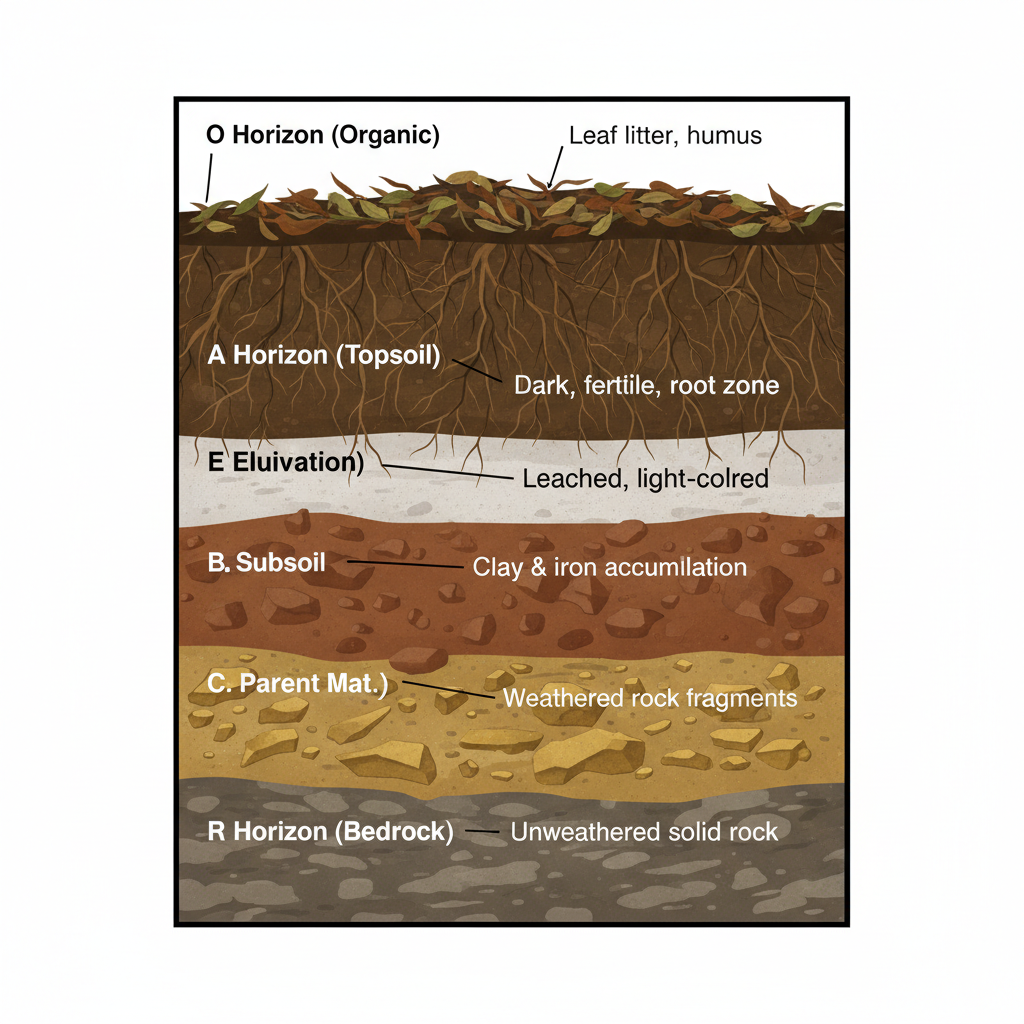Soil Profile
Introduction
- A soil profile is the vertical section of soil that shows its various layers or horizons — from the surface down to the unaltered parent material.
- It represents the natural sequence of layers that have developed through soil-forming processes (pedogenesis) over time.
- In simple terms: A soil profile is like a “slice” of soil from the top to bottom showing different horizons (O, A, B, C, and R).
Definition
- According to Soil Science Society of America (SSSA):
“A soil profile is a vertical section of soil extending through all its horizons and into the parent material.” - In Simple Words:
A soil profile is a cross-sectional view of the soil that reveals distinct layers (horizons) formed due to weathering, organic accumulation, and leaching.
Importance of Soil Profile
Understanding the soil profile helps to:
- Identify soil type and fertility.
- Understand soil formation and age.
- Know water-holding capacity and root penetration depth.
- Classify soils for agricultural and engineering uses.
- Assess land suitability and soil management practices.
Components of a Soil Profile
A typical soil profile consists of five major horizons:
|
Horizon Symbol |
Name |
Position |
General Characteristics |
|
O Horizon |
Organic Horizon |
Topmost |
Rich in organic matter (litter, decomposed leaves). |
|
A Horizon |
Surface Soil (Topsoil) |
Below O horizon |
Zone of leaching and high biological activity. |
|
B Horizon |
Subsoil |
Below A horizon |
Zone of accumulation (illuviation) of clay, iron, etc. |
|
C Horizon |
Parent Material |
Below B horizon |
Weathered rock fragments; less biological activity. |
|
R Horizon |
Bedrock |
Lowest |
Unweathered parent rock; foundation layer. |
Detailed Description of Each Horizon
Let’s understand each layer in depth, from the surface downward 👇
(i) O Horizon – Organic Layer
- Location: Uppermost layer (surface).
- Composition: Mostly organic matter — undecomposed or partially decomposed leaves, twigs, roots, and animal residues.
- Color: Dark brown or black due to humus content.
- Processes: Accumulation of litter and humus. Active microbial decomposition.
- Subdivisions:
- Oi: Slightly decomposed organic material (litter layer).
- Oe: Moderately decomposed (fermentation layer).
- Oa: Highly decomposed (humus layer).
- Importance: Source of nutrients. Improves soil fertility and structure.
(ii) A Horizon – Topsoil
- Location: Immediately below O horizon (or surface if O is absent).
- Composition: Mixture of mineral particles (sand, silt, clay) and organic matter. Rich in microorganisms and roots.
- Processes:
- Leaching (Eluviation): Removal of clay, iron, and soluble minerals due to percolating water.
- Biological activity: Root growth, burrowing, and organic matter decomposition.
- Color: Dark brown to grayish brown.
- Importance: Most fertile and productive part of the soil. Major zone for plant growth and nutrient uptake.
- Designation: A1 (humus-rich), A2 (leached or eluviated).
(iii) E Horizon – Eluviation Zone (if present)
- Location: Between A and B horizons (not always distinct).
- Meaning: “E” stands for eluviation (washing out).
- Composition: Zone of maximum leaching (loss) of clay, iron, aluminum, and organic matter. Often lighter in color (ash-gray).
- Importance: Indicates strong leaching and advanced soil development.
- Common in: Forest soils and humid climates.
(iv) B Horizon – Subsoil
- Location: Below A or E horizon.
- Composition:
- Zone of accumulation (illuviation) — materials leached from upper horizons (clay, iron, aluminum, humus) are deposited here.
- Contains less organic matter but more minerals.
- Color: Reddish, yellowish, or brown (due to iron oxides and clay).
- Texture: Denser and harder than A horizon.
- Processes:
- Illuviation: Deposition of materials from above.
- Clay accumulation (argillic horizon).
- Iron/aluminum enrichment (spodic horizon).
- Importance: Determines drainage, root depth, and nutrient movement. Acts as a storage zone for nutrients.
(v) C Horizon – Parent Material
- Location: Beneath B horizon.
- Composition:
- Partially disintegrated and weathered rock fragments.
- Very little biological activity or organic matter.
- Color: Variable, often lighter.
- Processes: Physical weathering dominates. Source of minerals for upper layers.
- Importance: Determines texture, structure, and mineral composition of overlying soil horizons.
(vi) R Horizon – Bedrock
- Location: Lowest layer of the soil profile.
- Composition: Unweathered parent rock (granite, basalt, limestone, etc.).
- Characteristics: Hard and compact. No biological activity.
- Importance: Provides base material for soil formation through weathering.


